Using LVM
Flexible volume management
LVM2 permits you to create partitions spreading on multiple disk by grouping them in virtual volumes. It also enables the easy growing of existing partitions (but only if the filesystem permits it). That leads to a more scalable disk management because adding or deleting space is really easy without having to repartition the whole machine (most the time a server reinstallation is necessary).
Basic notions
The method used by LVM2 to manage many disks as one unit is to group them in what is so called a volume group For this, it is mandatory to create a physical volume, operation that prepares one partition, one entire disk or one file in a LVM2 usable format.
This can be done by the pvcreate commmand.
As an exemple, if I have one 6.4GB disk located in /dev/hdb and one 40GB disk located in /dev/hde, this is how I would initilize them:
pvcreate /dev/hdb
Physical volume "/dev/hdb" successfully created
pvcreate /dev/hde
Physical volume "/dev/hde" successfully created
We can verify that the two physical volumes are presented to the system using the pvdisplay command:
pvdisplay
--- NEW Physical volume ---
PV Name /dev/hde
VG Name
PV Size 37.27 GB
Allocatable NO
PE Size (KByte) 0
Total PE 0
Free PE 0
Allocated PE 0
PV UUID f0iIbU-ayPe-kpoy-d3bP-hfDP-JqPO-5MVLT7
--- NEW Physical volume ---
PV Name /dev/hdb
VG Name
PV Size 6.01 GB
Allocatable NO
PE Size (KByte) 0
Total PE 0
Free PE 0
Allocated PE 0
PV UUID yV0Qht-jGSe-jdDo-jErn-cgYi-tbR6-ITqrz1
We now have two disks prepared to use in a volume group. It is now necessary to create a volume group using the vgcreate command (we will call the volume group in this exemple the lvmspace):
vgcreate lvmspace /dev/hdb
Volume group "lvmspace" successfully created
The volume group is now created and is of 6.1GB, fact that we can check with the vgdisplay command:
vgdisplay
--- Volume group ---
VG Name lvmspace
System ID
Format lvm2
Metadata Areas 1
Metadata Sequence No 1
VG Access read/write
VG Status resizable
MAX LV 0
Cur LV 0
Open LV 0
Max PV 0
Cur PV 1
Act PV 1
VG Size 6.00 GB
PE Size 4.00 MB
Total PE 1537
Alloc PE / Size 0 / 0
Free PE / Size 1537 / 6.00 GB
VG UUID W7zp0w-pYZk-xkg1-9u37-9kiI-30uM-yA6Yji
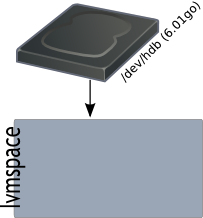
The next operation will extend the volume group with /dev/hde disk size using the vgextend.
vgextend lvmspace /dev/hde
/dev/cdrom: open failed: Read-only file system
/dev/cdrom: open failed: Read-only file system
Attempt to close device '/dev/cdrom' which is not open.
Volume group "lvmspace" successfully extended
[!NOTE] Don’t pay attention to the warnings related to the cdrom drive.
Here is a representation of the operation that we just did, aggregate two physical disk spaces in one virtual.
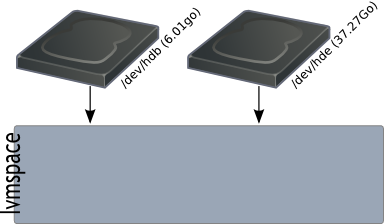
We can verify that the volume group size has changed:
vgdisplay
--- Volume group ---
VG Name lvmspace
System ID
Format lvm2
Metadata Areas 2
Metadata Sequence No 2
VG Access read/write
VG Status resizable
MAX LV 0
Cur LV 0
Open LV 0
Max PV 0
Cur PV 2
Act PV 2
VG Size 43.27 GB
PE Size 4.00 MB
Total PE 11078
Alloc PE / Size 0 / 0
Free PE / Size 11078 / 43.27 GB
VG UUID W7zp0w-pYZk-xkg1-9u37-9kiI-30uM-yA6Yji
And now pvdisplay show that the disks have been completely affected to the volume group:
pvdisplay
--- Physical volume ---
PV Name /dev/hdb
VG Name lvmspace
PV Size 6.00 GB / not usable 0
Allocatable yes
PE Size (KByte) 4096
Total PE 1537
Free PE 1537
Allocated PE 0
PV UUID yV0Qht-jGSe-jdDo-jErn-cgYi-tbR6-ITqrz1
--- Physical volume ---
PV Name /dev/hde
VG Name lvmspace
PV Size 37.27 GB / not usable 0
Allocatable yes
PE Size (KByte) 4096
Total PE 9541
Free PE 9541
Allocated PE 0
PV UUID f0iIbU-ayPe-kpoy-d3bP-hfDP-JqPO-5MVLT7Now that we have an usable virtual disk space, we can create partitions on it. These partitions are called logical volumes. Let’s create a 7GB logical volume with the lvcreate command:
lvcreate -L 7G -n home lvmspace
Logical volume "home" created

We can see the results of the precedent operation with the lvdisplay command:
lvdisplay
--- Logical volume ---
LV Name /dev/lvmspace/home
VG Name lvmspace
LV UUID icrus5-H10v-GqTG-NW0L-cwUR-FW2P-T5eqy1
LV Write Access read/write
LV Status available
# open 0
LV Size 7.00 GB
Current LE 1792
Segments 2
Allocation inherit
Read ahead sectors 0
Block device 253:0
We can also see that the created logical volume consumes all the space of /dev/hdb and a small part of /dev/hde:
pvdisplay
--- Physical volume ---
PV Name /dev/hdb
VG Name lvmspace
PV Size 6.00 GB / not usable 0
Allocatable yes (but full)
PE Size (KByte) 4096
Total PE 1537
Free PE 0
Allocated PE 1537
PV UUID yV0Qht-jGSe-jdDo-jErn-cgYi-tbR6-ITqrz1
--- Physical volume ---
PV Name /dev/hde
VG Name lvmspace
PV Size 37.27 GB / not usable 0
Allocatable yes
PE Size (KByte) 4096
Total PE 9541
Free PE 9286
Allocated PE 255
PV UUID f0iIbU-ayPe-kpoy-d3bP-hfDP-JqPO-5MVLT7
Let’s now create a logical volume of 20GB named var:
lvcreate -L 20G -n var lvmspace
Logical volume "var" created
And as result we have:
lvdisplay
--- Logical volume ---
LV Name /dev/lvmspace/home
VG Name lvmspace
LV UUID icrus5-H10v-GqTG-NW0L-cwUR-FW2P-T5eqy1
LV Write Access read/write
LV Status available
# open 0
LV Size 7.00 GB
Current LE 1792
Segments 2
Allocation inherit
Read ahead sectors 0
Block device 253:0
--- Logical volume ---
LV Name /dev/lvmspace/var
VG Name lvmspace
LV UUID GNPaI1-7jlr-oUYZ-6qot-1cS8-gN8G-Ig6cJ2
LV Write Access read/write
LV Status available
# open 0
LV Size 20.00 GB
Current LE 5120
Segments 1
Allocation inherit
Read ahead sectors 0
Block device 253:1
We now see that 27GB are occupied in the lvmspace.
vgdisplay
--- Volume group ---
VG Name lvmspace
System ID
Format lvm2
Metadata Areas 2
Metadata Sequence No 4
VG Access read/write
VG Status resizable
MAX LV 0
Cur LV 2
Open LV 0
Max PV 0
Cur PV 2
Act PV 2
VG Size 43.27 GB
PE Size 4.00 MB
Total PE 11078
Alloc PE / Size 6912 / 27.00 GB
Free PE / Size 4166 / 16.27 GB
VG UUID W7zp0w-pYZk-xkg1-9u37-9kiI-30uM-yA6Yji
Let’s now create two logical volumes, one of 3GB named tmp and one of 13.27GB named portage to fulfill the whole available space:
lvcreate -L 3G -n tmp lvmspace
Logical volume "tmp" created
lvcreate -L 13.27G -n portage lvmspace
Rounding up size to full physical extent 13.27 GB
Logical volume "portage" created
We now see that there’s no more available space in the volume group:
vgdisplay
--- Volume group ---
VG Name lvmspace
System ID
Format lvm2
Metadata Areas 2
Metadata Sequence No 6
VG Access read/write
VG Status resizable
MAX LV 0
Cur LV 4
Open LV 0
Max PV 0
Cur PV 2
Act PV 2
VG Size 43.27 GB
PE Size 4.00 MB
Total PE 11078
Alloc PE / Size 11078 / 43.27 GB
Free PE / Size 0 / 0
VG UUID W7zp0w-pYZk-xkg1-9u37-9kiI-30uM-yA6Yji
We are now in the following situation:
ls /dev/lvmspace/
home portage tmp var
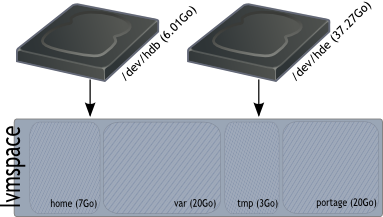
Let’s now create filesystems on these logical volumes to use them as normal partitions:
mkfs.ext3 /dev/lvmspace/tmp -L "/tmp"
mkfs.ext3 /dev/lvmspace/var -L "/var"
mkfs.reiserfs /dev/lvmspace/portage -l "/usr/portage"
mkfs.reiserfs /dev/lvmspace/home -l "/home"
We have now the following:
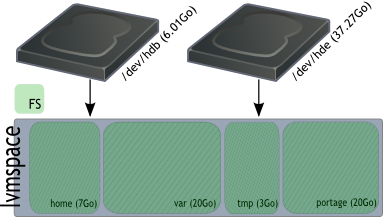
In the next chapter, we’ll see how convenient the usage of LVM2 is.
Logical volume resizing
Let’s add a new physical hard drive to the system, and prepare it for LVM:
pvcreate /dev/hdg
Physical volume "/dev/hdg" successfully created
Now, extend the volume group:
vgextend lvmspace /dev/hdg
/dev/cdrom: open failed: Read-only file system
Attempt to close device '/dev/cdrom' which is not open.
Volume group "lvmspace" successfully extended
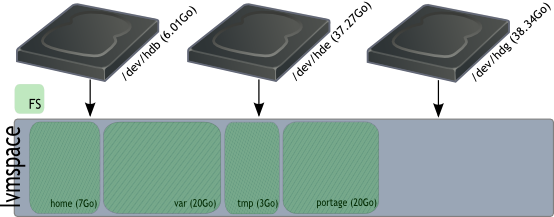
vgdisplay
--- Volume group ---
VG Name lvmspace
System ID
Format lvm2
Metadata Areas 3
Metadata Sequence No 7
VG Access read/write
VG Status resizable
MAX LV 0
Cur LV 4
Open LV 0
Max PV 0
Cur PV 3
Act PV 3
VG Size 81.62 GB
PE Size 4.00 MB
Total PE 20894
Alloc PE / Size 11078 / 43.27 GB
Free PE / Size 9816 / 38.34 GB
VG UUID W7zp0w-pYZk-xkg1-9u37-9kiI-30uM-yA6Yji
We will now extend the home logical volume by 3GB. Now, it’s really important to get the fact that we will extend the backend, now the partition that we created on it. It will be necessary to resize the filesystem in order to use the space in it’s totality. The following scheme explains the difference:
lvextend -L +3G /dev/lvmspace/home
Extending logical volume home to 10.00 GB
Logical volume home successfully resized
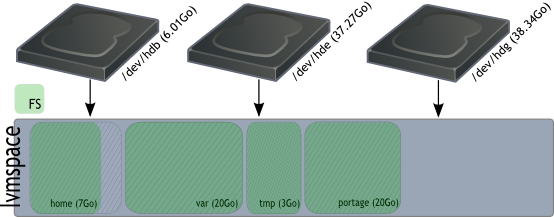
We now see that home is now 10GB big.
lvdisplay /dev/lvmspace/home
--- Logical volume ---
LV Name /dev/lvmspace/home
VG Name lvmspace
LV UUID icrus5-H10v-GqTG-NW0L-cwUR-FW2P-T5eqy1
LV Write Access read/write
LV Status available
# open 0
LV Size 10.00 GB
Current LE 2560
Segments 3
Allocation inherit
Read ahead sectors 0
Block device 253:0
We will now extend the filesystem on home using a reiserfs specific command called resize_reiserfs:
[!WARNING] Warning: This can only be done on one unmounted partition.
resize_reiserfs -s+3G /dev/lvmspace/home
resize_reiserfs 3.6.19 (2003 www.namesys.com)
ReiserFS report:
blocksize 4096
block count 2621440 (1835008)
free blocks 2613149 (1826741)
bitmap block count 80 (56)
Syncing..done
resize_reiserfs: Resizing finished successfully.
We will now extend var and the filesystem with the resize2fs command by 5GB :
[!NOTE] Info: Unlike resize_reiserfs, it’s possible to extend a ext3 filesystem without having to dismount the logical volume. This should be considered as an serious asset of ext3 over reiserfs on production systems.
lvextend -L +5G /dev/lvmspace/var
Extending logical volume var to 25.00 GB
Logical volume var successfully resized
resize2fs /dev/lvmspace/var 25G
resize2fs 1.38 (30-Jun-2005)
Resizing the filesystem on /dev/lvmspace/var to 6553600 (4k) blocks.
The filesystem on /dev/lvmspace/var is now 6553600 blocks long.
We have the following situation:
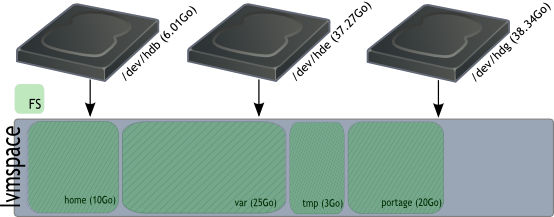
Logical volume shrinking
Let’s say for some reason that we don’t want to have 10GB on home. The method to follow to proceed with the shrinking is first to shrink the existing filesystem then shrink the logical volume :
[!WARNING] Alert: You can crash you data when shrinking, so be carefull !
Filesystem shrink :
osiris ~ # resize_reiserfs -s-1G /dev/lvmspace/home
resize_reiserfs 3.6.19 (2003 www.namesys.com)
You are running BETA version of reiserfs shrinker.
This version is only for testing or VERY CAREFUL use.
Backup of you data is recommended.
Do you want to continue? [y/N]:y
Processing the tree: 0%....20%....40%....60%....80%....100% left 0, 0 /sec
nodes processed (moved):
int 0 (0),
leaves 1 (0),
unfm 0 (0),
total 1 (0).
check for used blocks in truncated region
ReiserFS report:
blocksize 4096
block count 2359296 (2621440)
free blocks 2351013 (2613149)
bitmap block count 72 (80)
Syncing..done
resize_reiserfs: Resizing finished successfully.
Logical volume resize :
lvresize -L -1G /dev/lvmspace/home
WARNING: Reducing active logical volume to 9.00 GB
THIS MAY DESTROY YOUR DATA (filesystem etc.)
Do you really want to reduce home? [y/n]: y
Reducing logical volume home to 9.00 GB
Logical volume home successfully resized
You now know how to embiggen and shrink logical volumes and extend volume groups, you can now do many things with this awesome technology that LVM is !